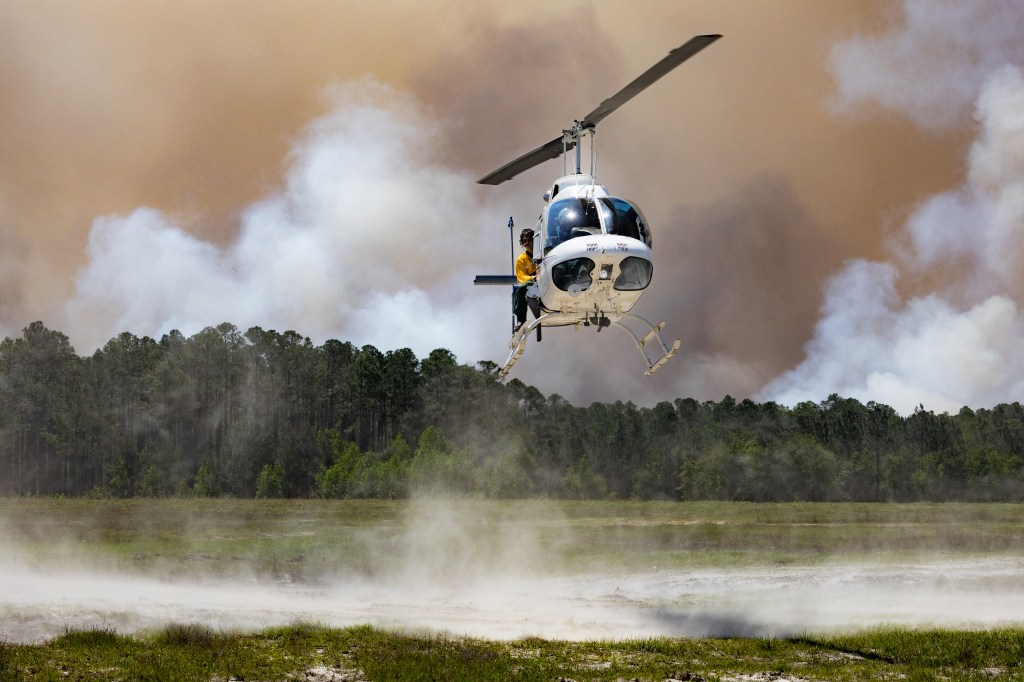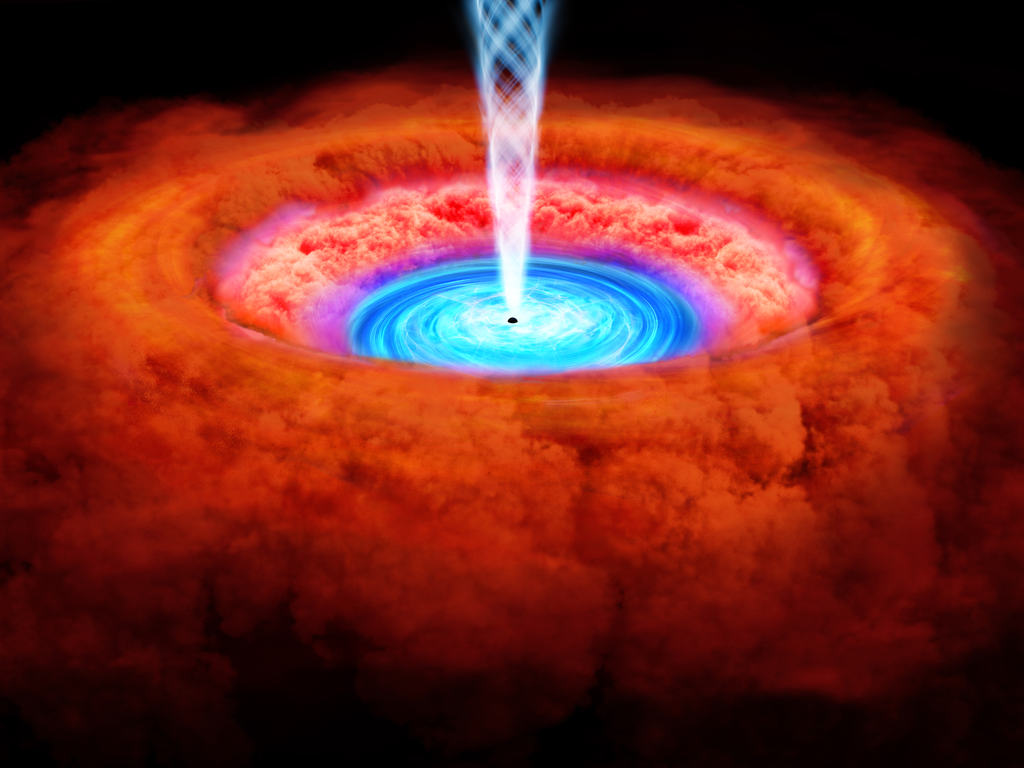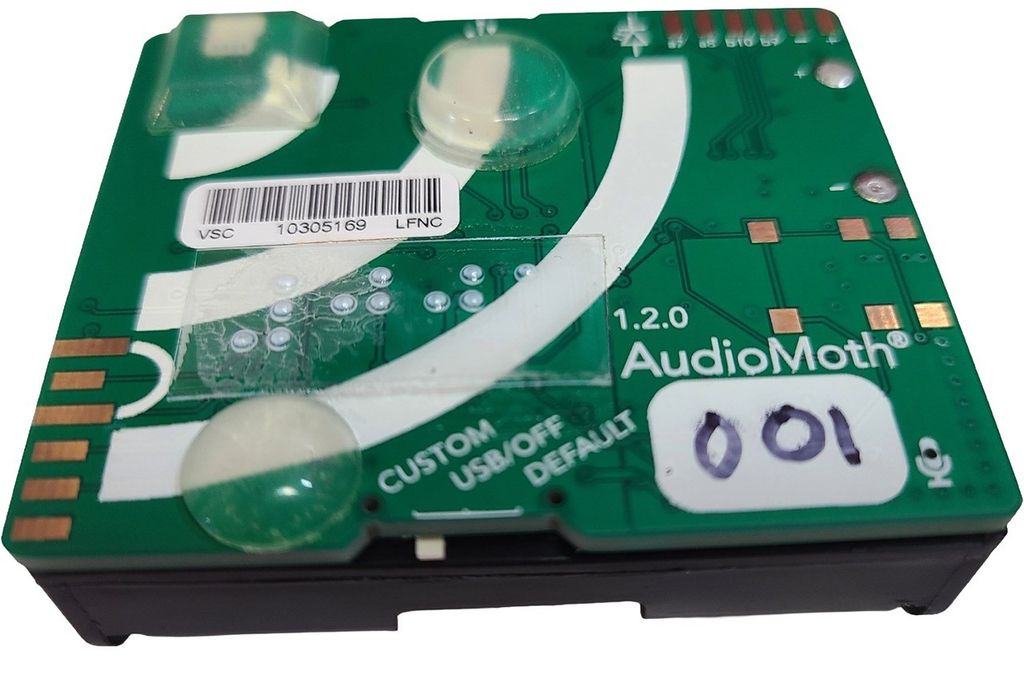In April 2001, as the Expedition 2 crew of Yuri V. Usachev of Roscosmos and NASA astronauts James S. Voss and Susan J. Helms completed their first month aboard the International Space Station (ISS), the space shuttle Endeavour arrived at the space station on the STS-100 mission to install the Canadarm2 robotic system. During their first month in space, the Expedition 2 crew continued to commission the orbiting laboratory and conducted early research. They monitored the departure of a Progress cargo resupply vehicle and relocated their Soyuz spacecraft during a short flight around the space station. In addition to installing Canadarm2, the seven-member STS-100 crew, representing four of the ISS Program’s partner agencies, also brought new facilities to expand the research capabilities of the growing space station.
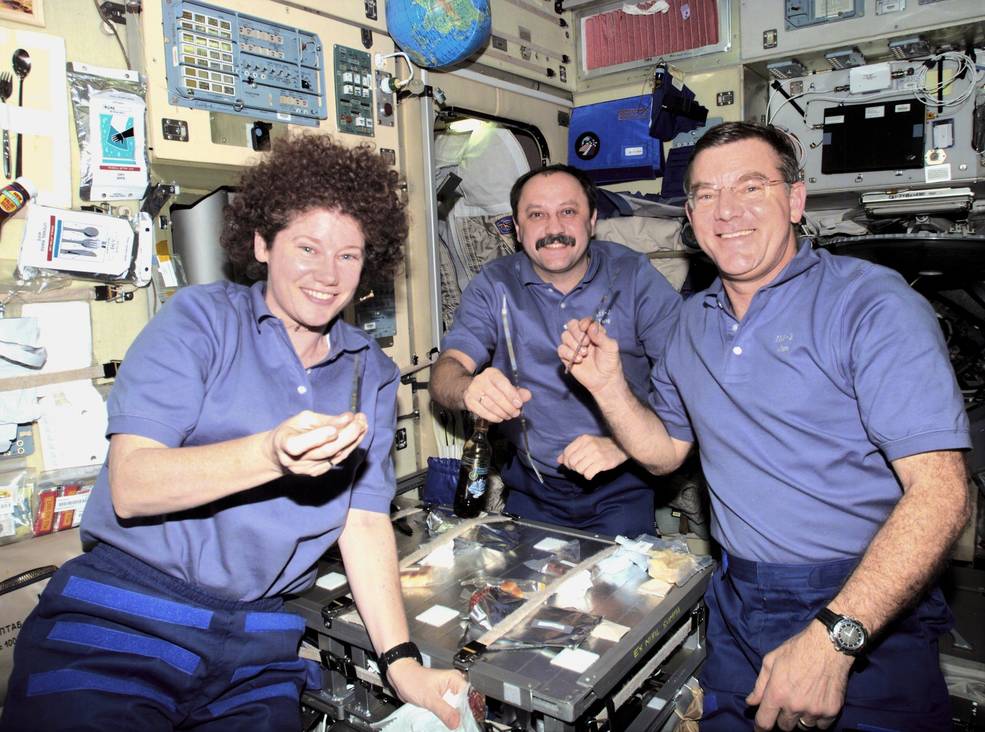
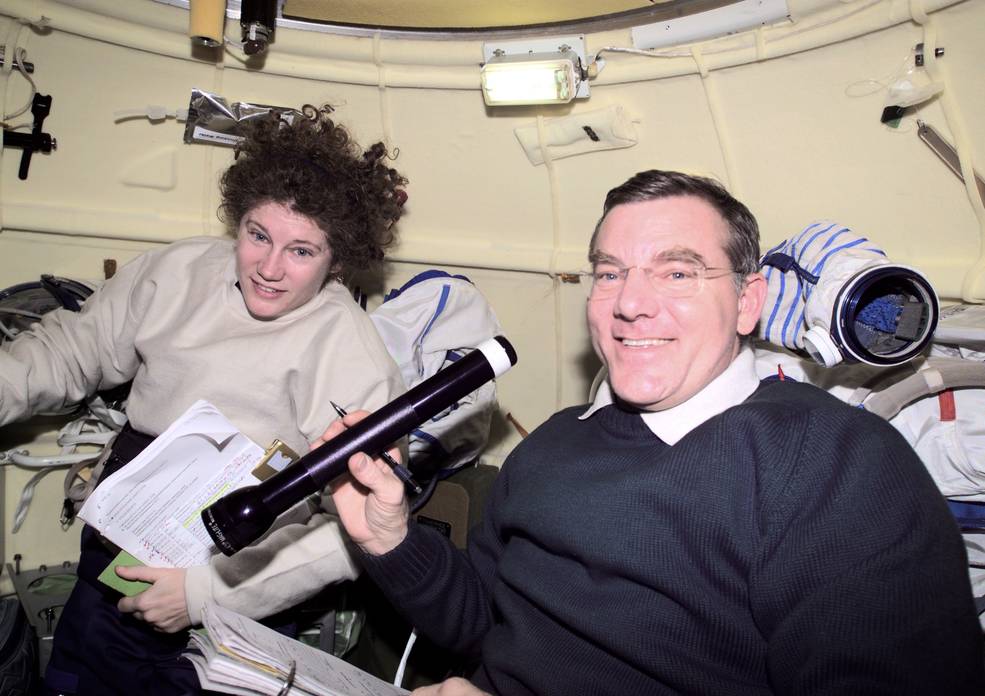
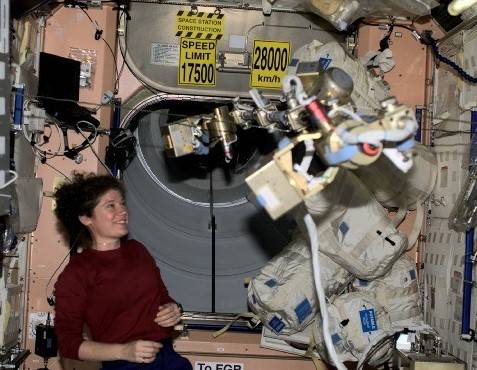
Left: Expedition 2 crew members Susan J. Helms, left, Yuri V. Usachev, and James S. Voss enjoy a meal together in the Zvezda module. Middle: Helms, left, and Voss in the Soyuz spacecraft’s orbital module in preparation for the relocation. Right: Helms working with the Middeck Active Control Experiment-II in the Unity module.
Following the departure from the space station of the space shuttle Discovery on March 19, 2001, Expedition 2 crew members Usachev, Voss, and Helms began their long-duration mission in earnest. They continued the commissioning of the Destiny U.S. laboratory module begun by the Expedition 1 crew. Helms conducted sessions with the Middeck Active Control Experiment-II instrument, first started during Expedition 1. On April 16, they monitored the departure of the Progress M44 cargo resupply vehicle from the Zvezda Service Module’s aft port. Two days later, Usachev, Voss, and Helms donned their Sokol launch and entry suits and boarded their Soyuz TM31 spacecraft. With Usachev at the controls, they undocked from the Zarya module’s Earth-facing port and flew to the newly vacated Zvezda aft port, redocking after a 30-minute flight. The maneuver freed up a docking port for the next cargo resupply ship. Then they prepared for the arrival of the next space shuttle mission.
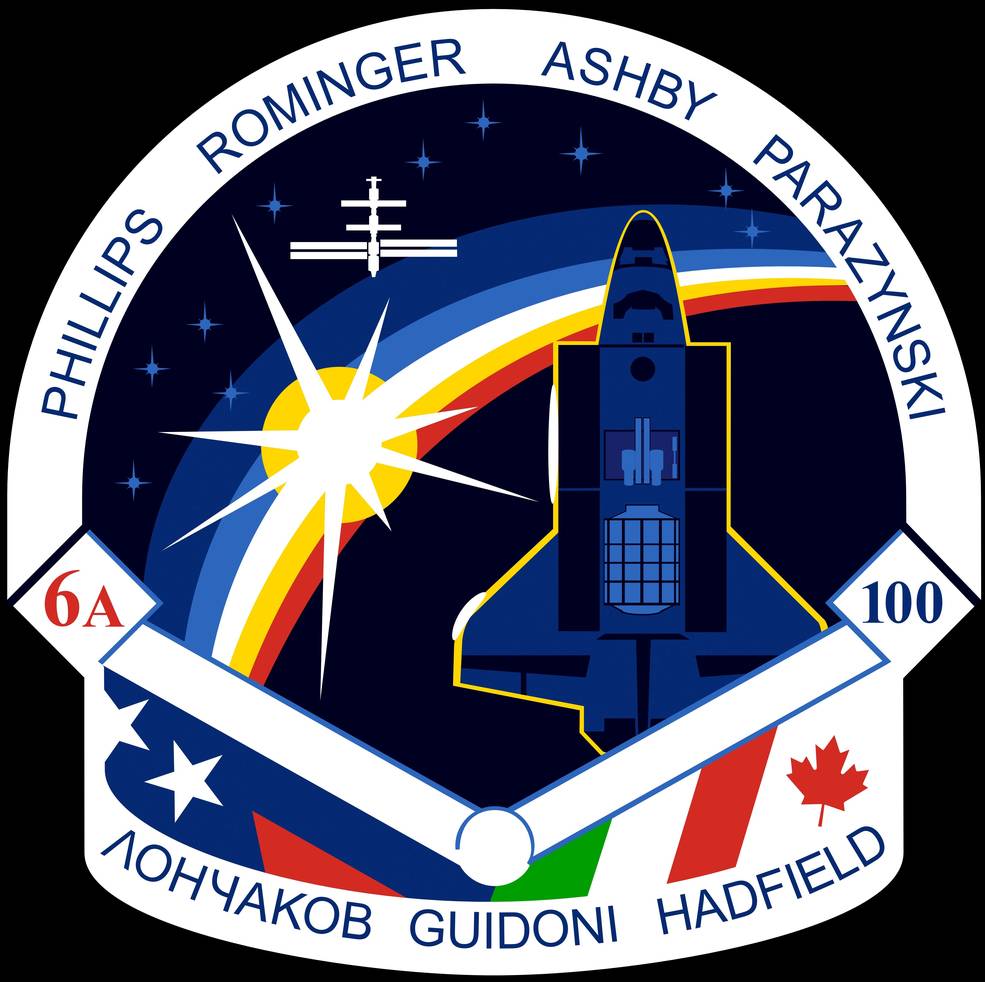
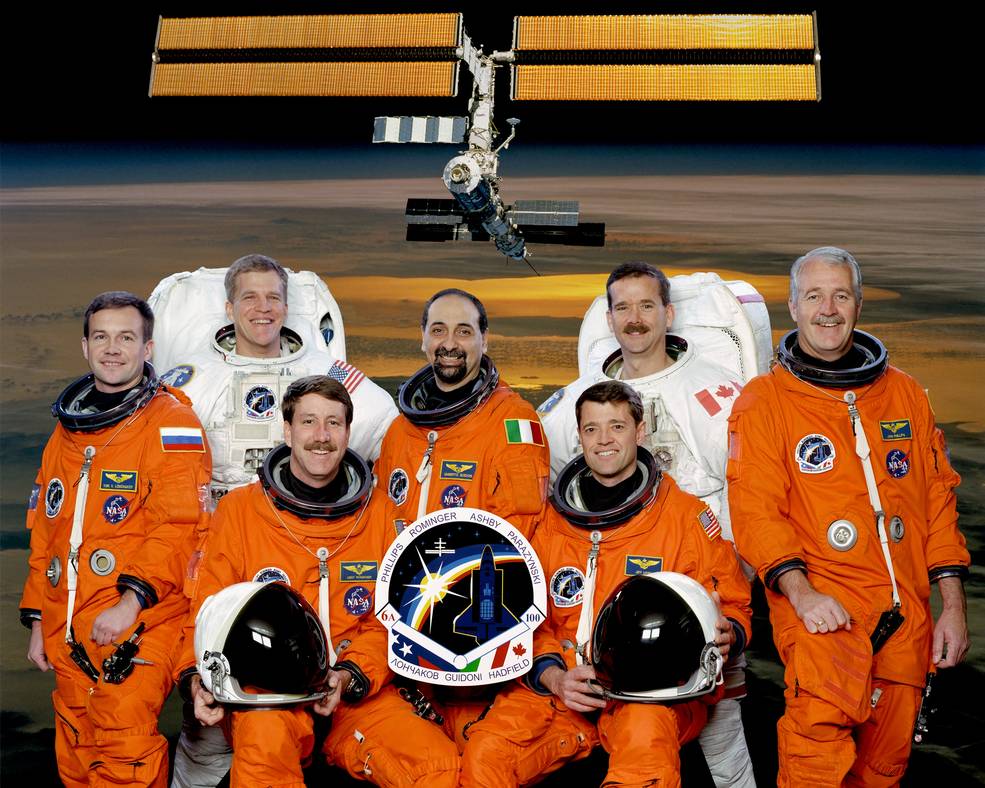
Left: The STS-100 crew patch. Right: The STS-100 crew of Yuri V. Lonchakov, left,
Scott E. Parazynski, Kent V. Rominger, Umberto Guidoni, Jeffrey S. Ashby, Chris A.
Hadfield, and John L. Phillips.
The ninth space shuttle assembly and resupply mission to the ISS, STS-100, began on the afternoon of April 19, 2001, with the launch of space shuttle Endeavour from Launch Pad 39A at NASA’s Kennedy Space Center (KSC) in Florida. STS-100 included the most internationally diverse shuttle crew, with four of the ISS partnership organizations represented – Commander Kent V. Rominger and Pilot Jeffrey S. Phillips of NASA, and Mission Specialists Chris A. Hadfield representing the Canadian Space Agency, John L. Phillips and Scott E. Parazynski of NASA, Umberto Guidoni of the European Space Agency, and Yuri V. Lonchakov of Roscosmos. Their mission to install the Canadarm2 robotic on the space station involved the most complex series of robotic tasks of any shuttle mission up to that point. Less than two days after launch, Rominger guided Endeavour to a smooth docking with the station at the Pressurized Mating Adapter-2, or PMA-2, located on the forward end of the U.S. laboratory module Destiny. Because the shuttle reduced its internal pressure for the spacewalk the next day, the hatches between the station and the shuttle wouldn’t be opened for two more days. The crews exchanged a few items using the PMA-2 as an airlock.
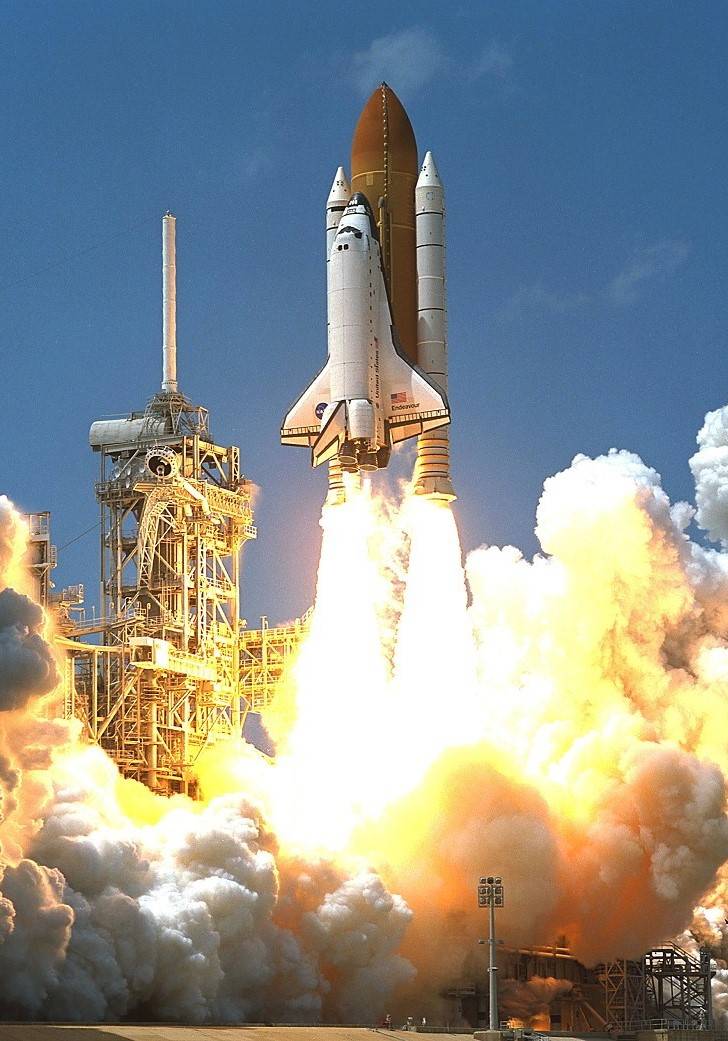
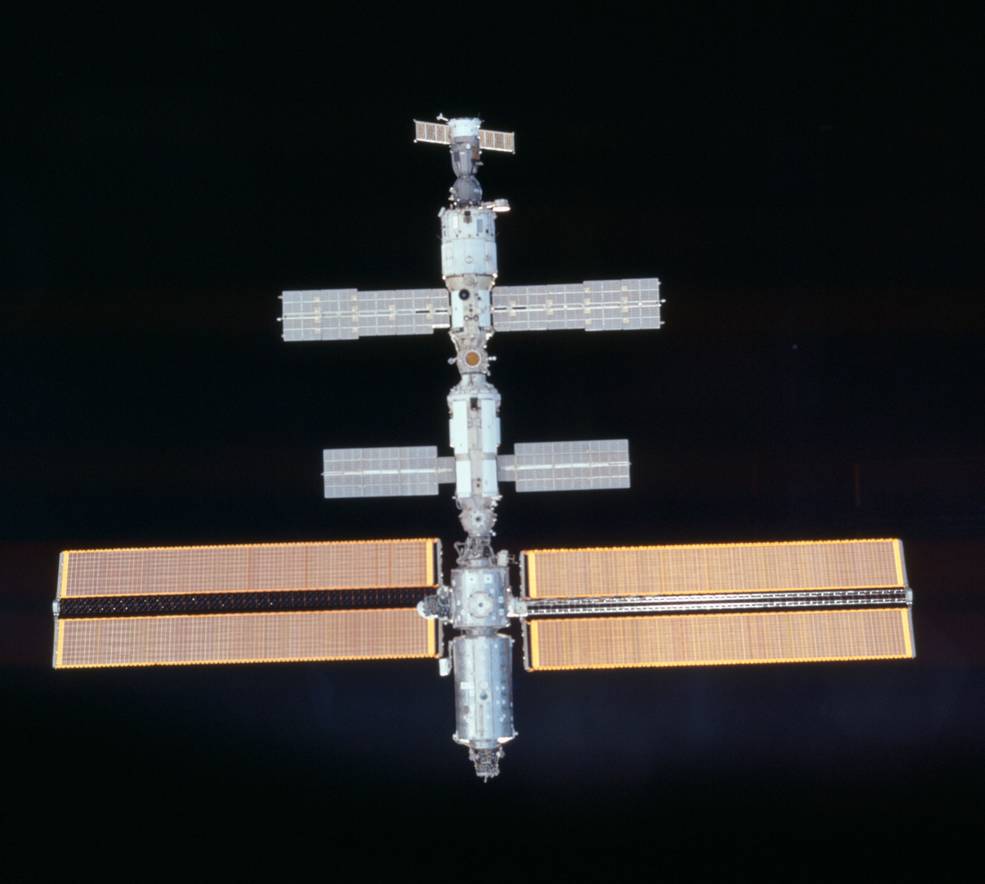
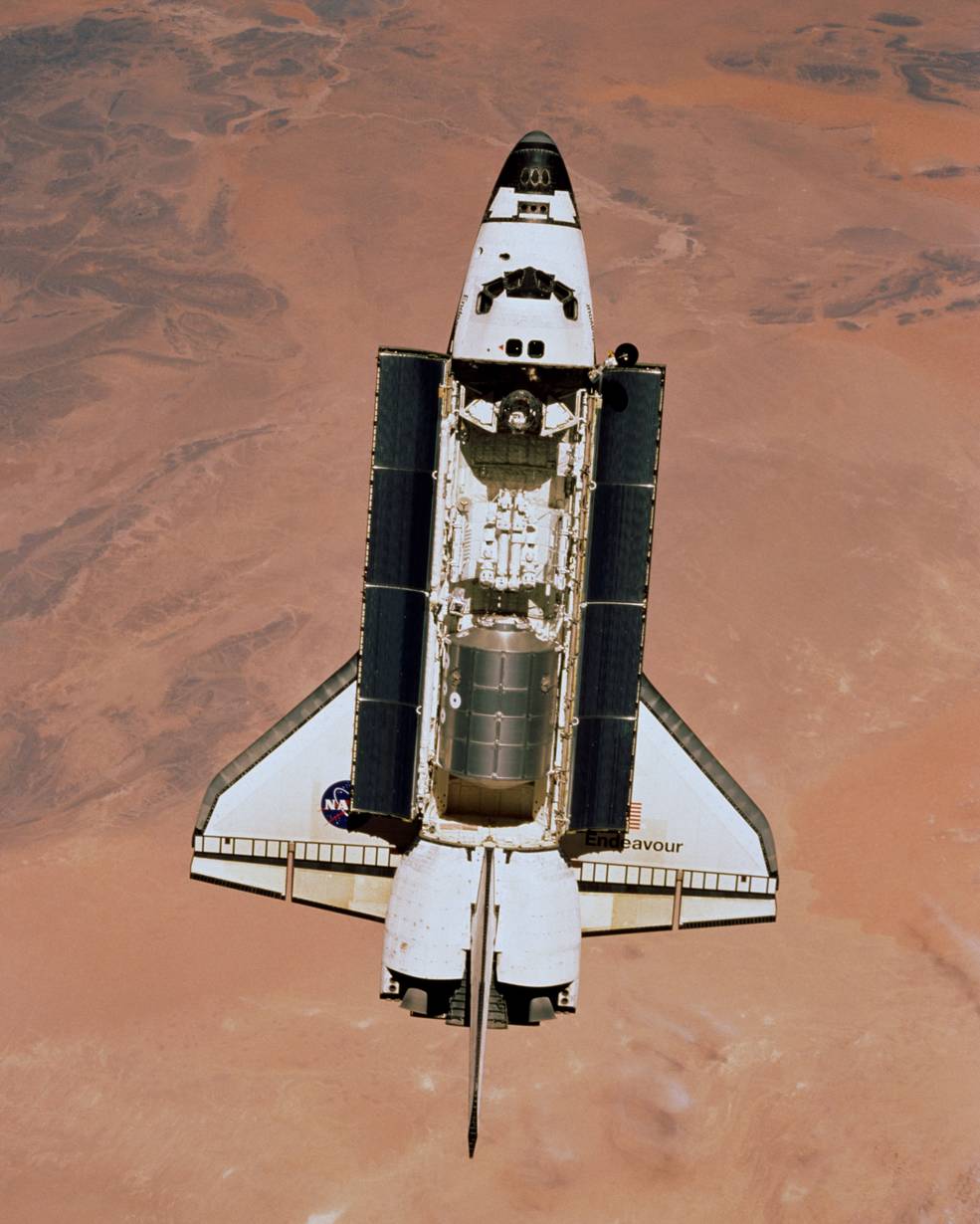
Left: Launch of Endeavour on space shuttle mission STS-100 from NASA’s Kennedy Space Center in Flordia. Middle: View of the International Space Station (ISS) from Endeavour during the rendezvous and docking maneuver. Right: View from inside the ISS of space shuttle Endeavour with the Raffaello Multi-Purpose Logistics Module and the Canadarm2 in the payload bay.
The day after the docking, Ashby used the Shuttle’s Canadarm Remote Manipulator System, first flown on STS-2 in 1981, to lift the pallet carrying the Canadarm2 and a UHF antenna out of the shuttle’s payload bay and transfer it to a temporary location on the Destiny module. Hadfield and Parazynski began the mission’s first spacewalk. Parazynski first installed the UHF antenna on the outside of Destiny, then he and Hadfield removed eight bolts that held the Canadarm2 in its pallet for launch. They manually unfold its arms, and connected communications cables between the station and the pallet as Helms and Voss tested the connections from the robotics workstation inside Destiny. The two spacewalkers returned to the shuttle’s airlock after spending 7 hours 10 minutes outside.
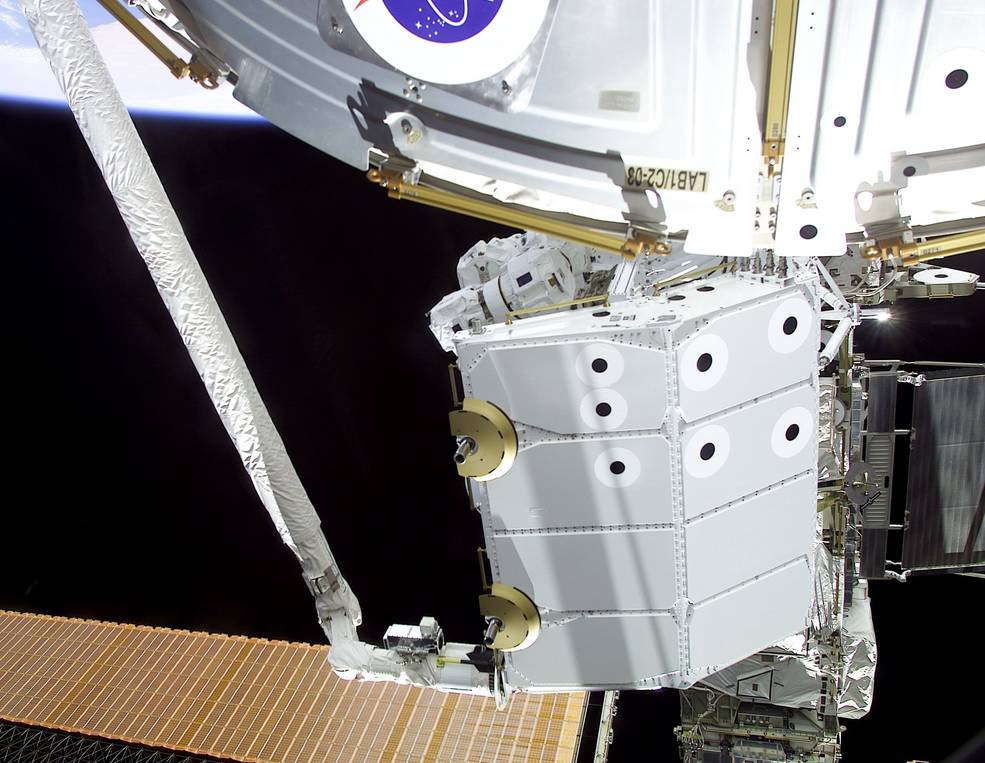
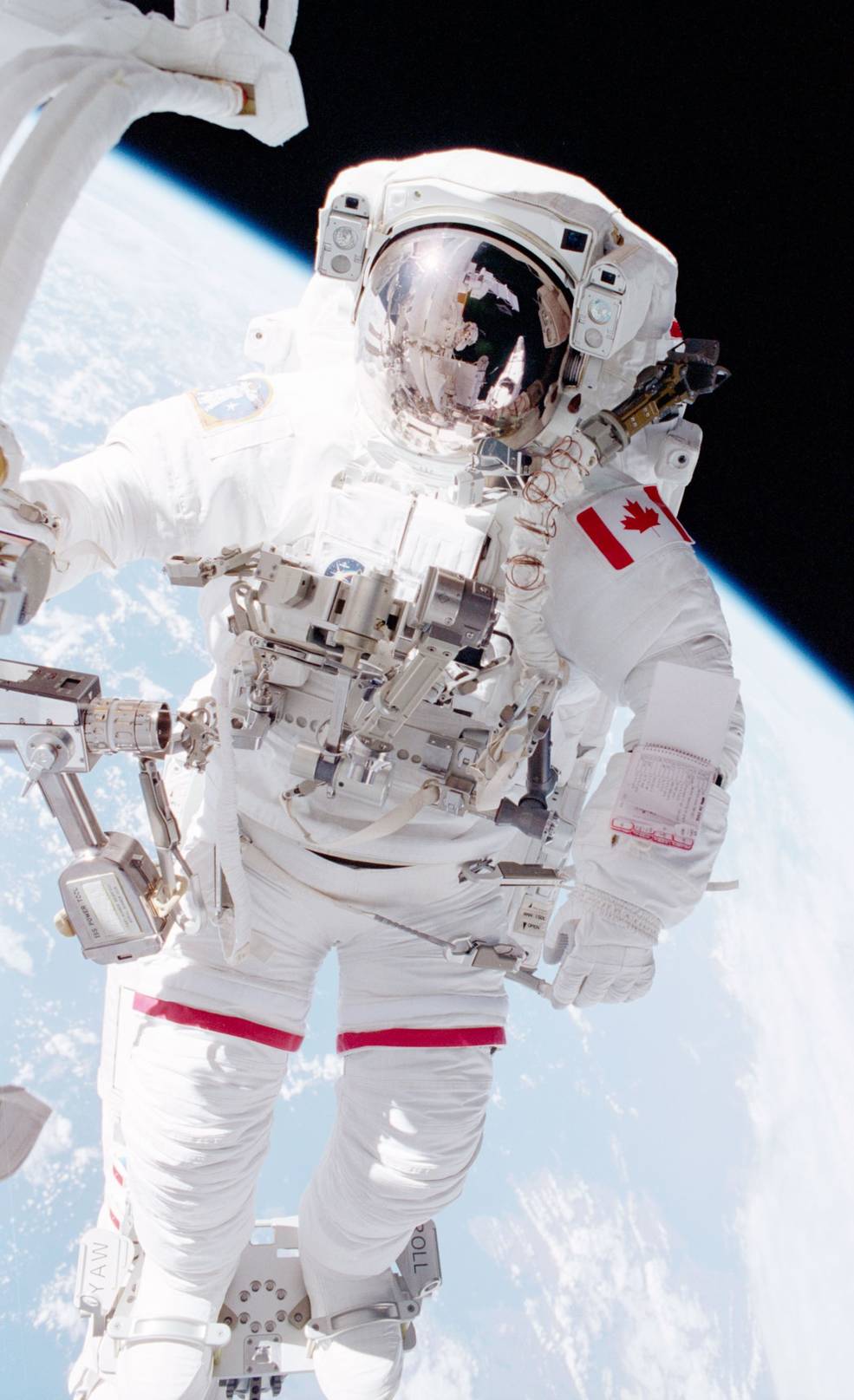
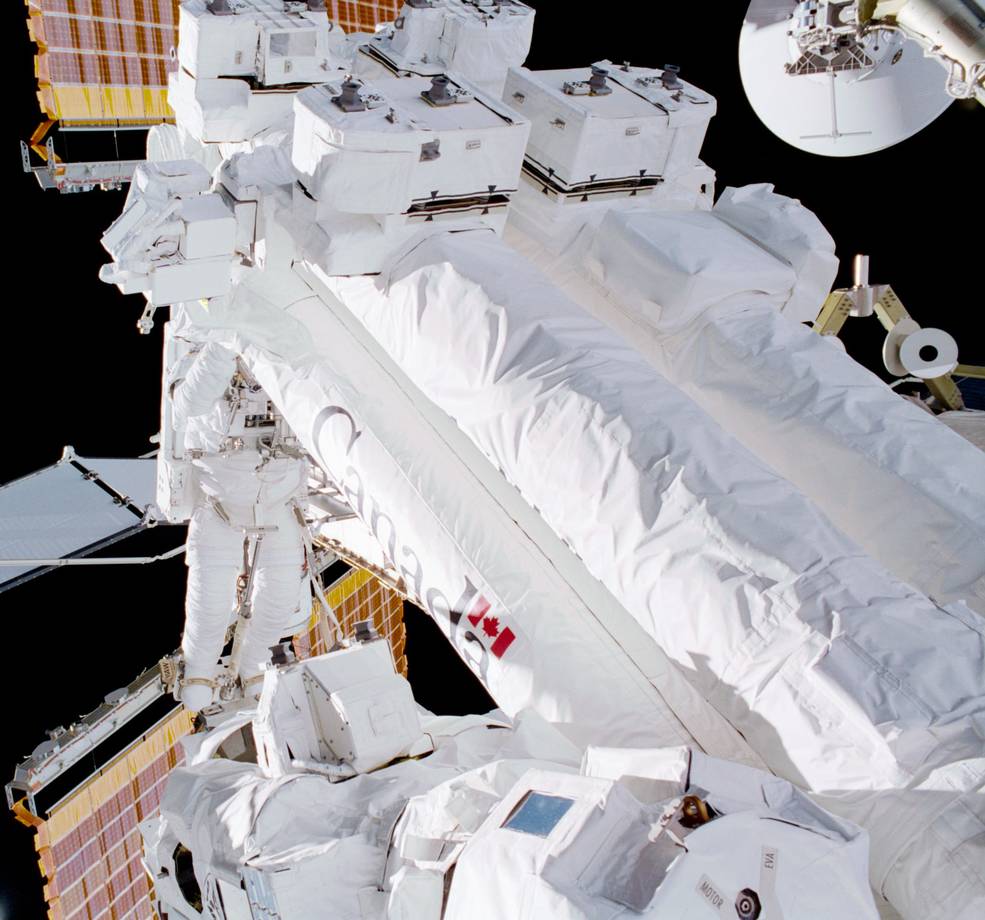
Left: Using the shuttle’s robotic arm, NASA astronaut Jeffrey S. Ashby has installed the pallet carrying the Canadarm2 and the UHF antenna onto the exterior of the Destiny module. Middle: Canadian Space Agency astronaut at work during the first STS-100 spacewalk. Right: NASA astronaut Scott E. Parazynski unfolding the arms of Canadarm2 during the first STS-100 spacewalk.
On the fifth day of the mission, the crews opened the hatches between the shuttle and the station and warmly greeted each other. Using the shuttle’s robotic arm, Guidoni and Parazynski lifted the 20,000-pound Raffaello Multi-Purpose Logistics Module (MPLM) out of the payload bay and transferred it to the Unity module’s Earth-facing berthing port. Using the robotics workstation, Helms and Voss activated Canadarm2 and maneuvered it for the first time, commanding it to attach to a grapple fixture on Destiny’s exterior. At the end of the day, the crews returned to their respective spacecraft and closed the hatches in preparation for the following day’s second spacewalk.
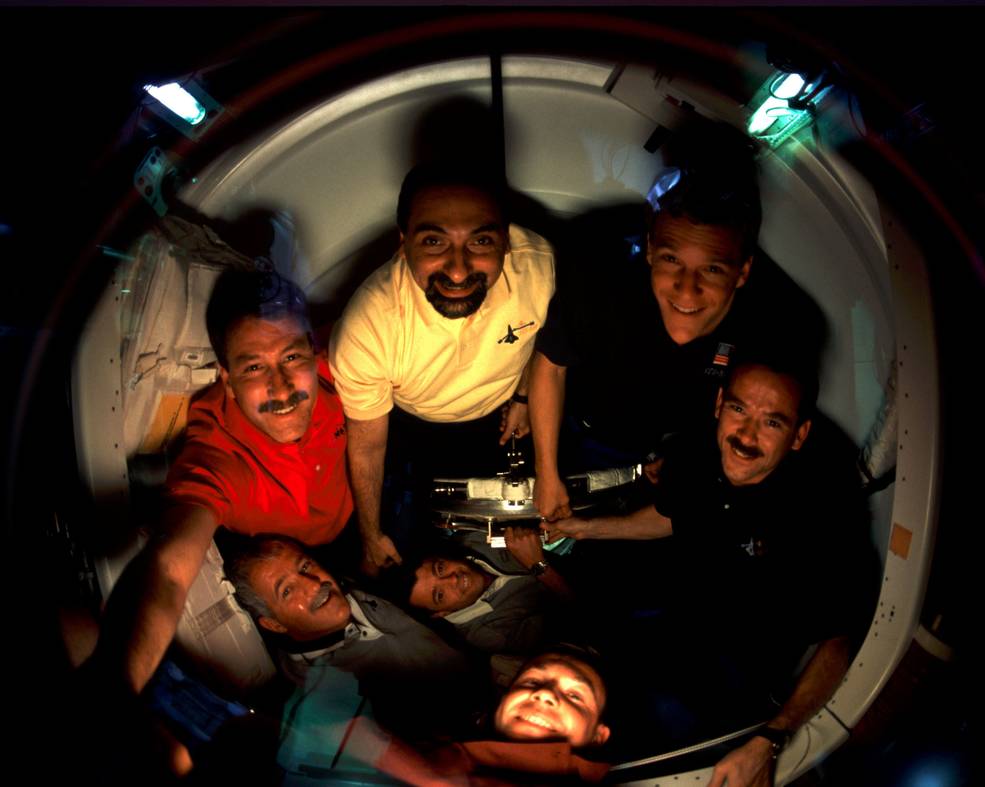
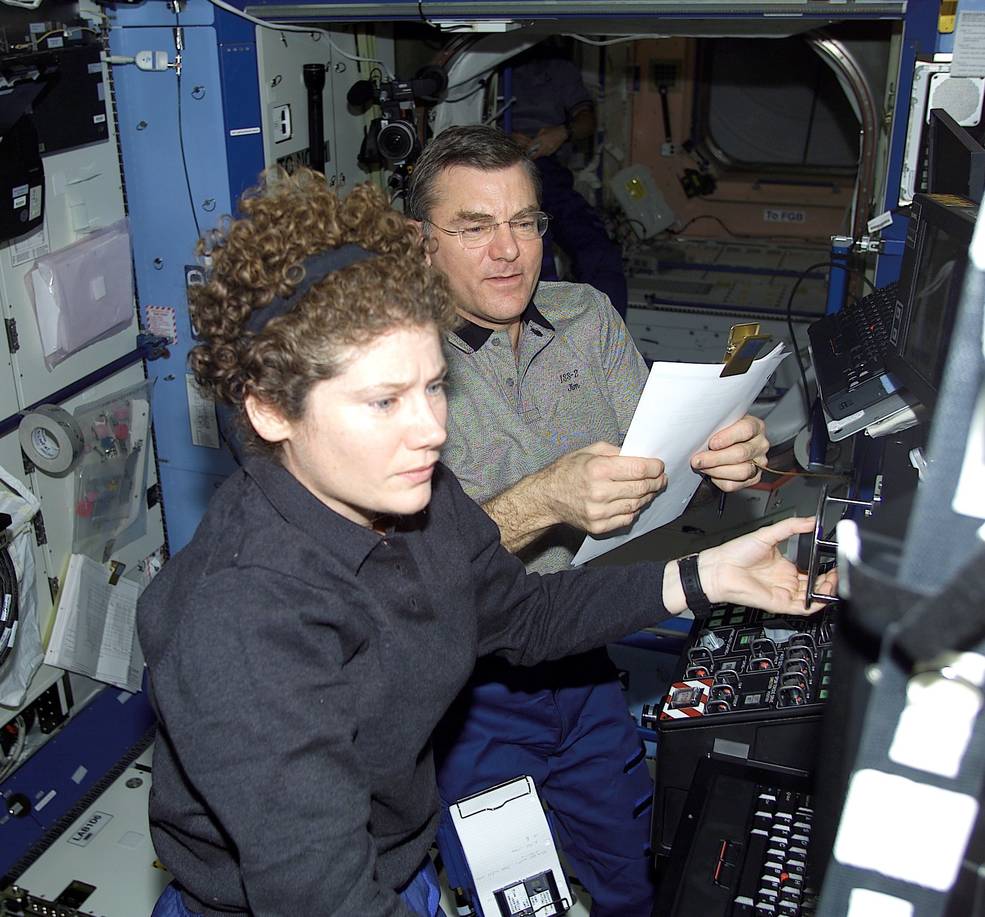
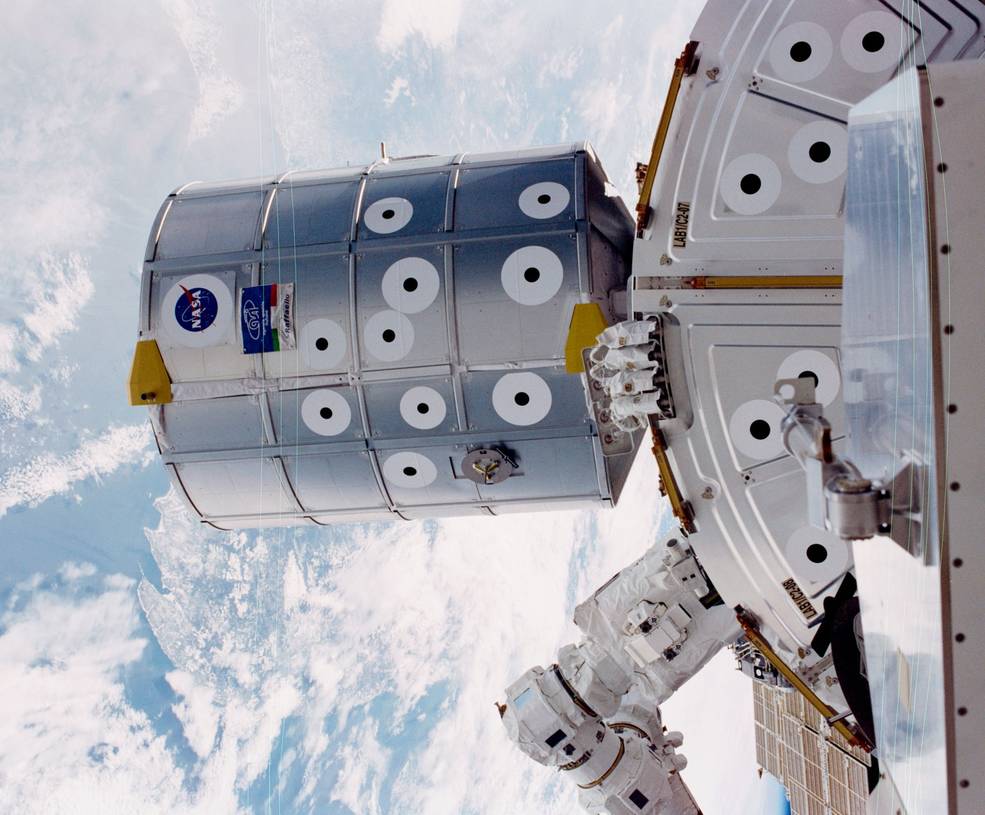
Left: The STS-100 crew gathered in the Pressurized Mating Adapter-2 eagerly awaiting the opening of the hatches between the shuttle and the station. Right: Expedition 2 astronauts Susan J. Helms, left, and James S. Voss controlling the Canadarm2 from the Destiny module’s robotic workstation. Right: The Rafaello Multi-Purpose Logistics Module temporarily installed on the Unity module’s Earth-facing port.
The next day, Guidoni opened the hatches to the berthed MPLM, enabling the transfer of 6,000 pounds of cargo, including two science racks, to the space station. The Payload Operations Integration Center (POIC) at NASA’s Marshall Space Flight Center in Huntsville, Alabama, monitored the activation and operations of the two Expedite the Processing of Payloads for Space Station (EXPRESS) racks, and the transfer of active experiments into one of the facilities. The POIC has served as the nerve center for all NASA research activities aboard the ISS for more than 20 years. Meanwhile, Hadfield and Parazynski ventured outside for their second spacewalk. They began the 7-hour 40-minute excursion by installing cables to connect the Canadarm2 to its grapple fixture on Destiny’s exterior. Helms and Voss activated the robotic arm, now a permanent fixture on the space station, and as Hadfield and Parazynski watched, they commanded it to lift the pallet off the station and hold it in a temporary parked position. The spacewalkers completed their excursion after installing a new avionics component and removing unneeded equipment from the station’s exterior. At the end of the day, the crews reopened the hatches between the station and the shuttle.
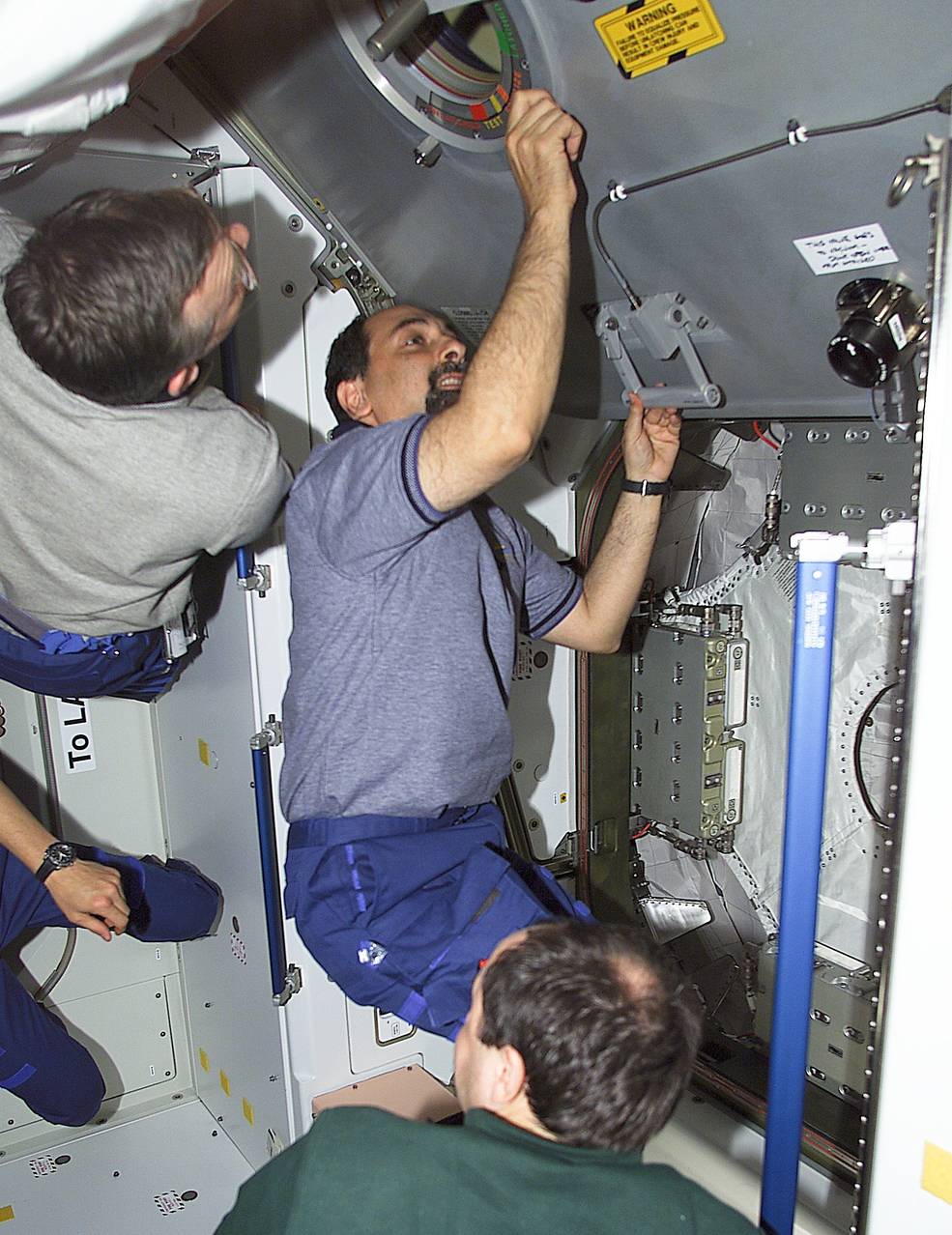
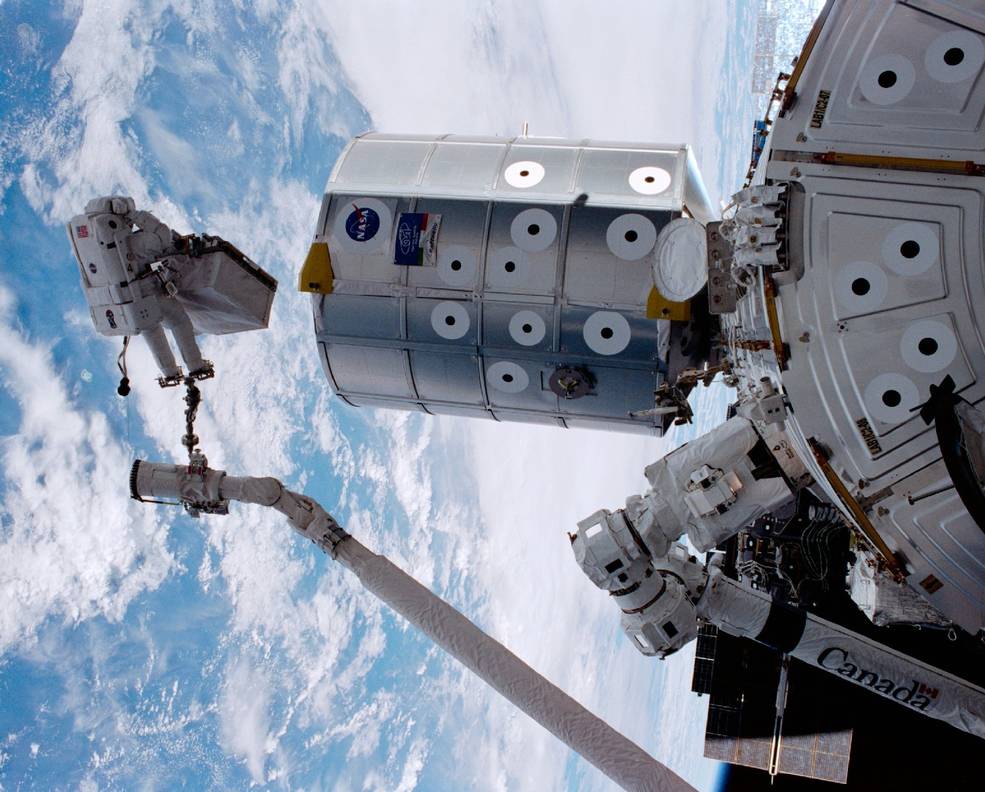
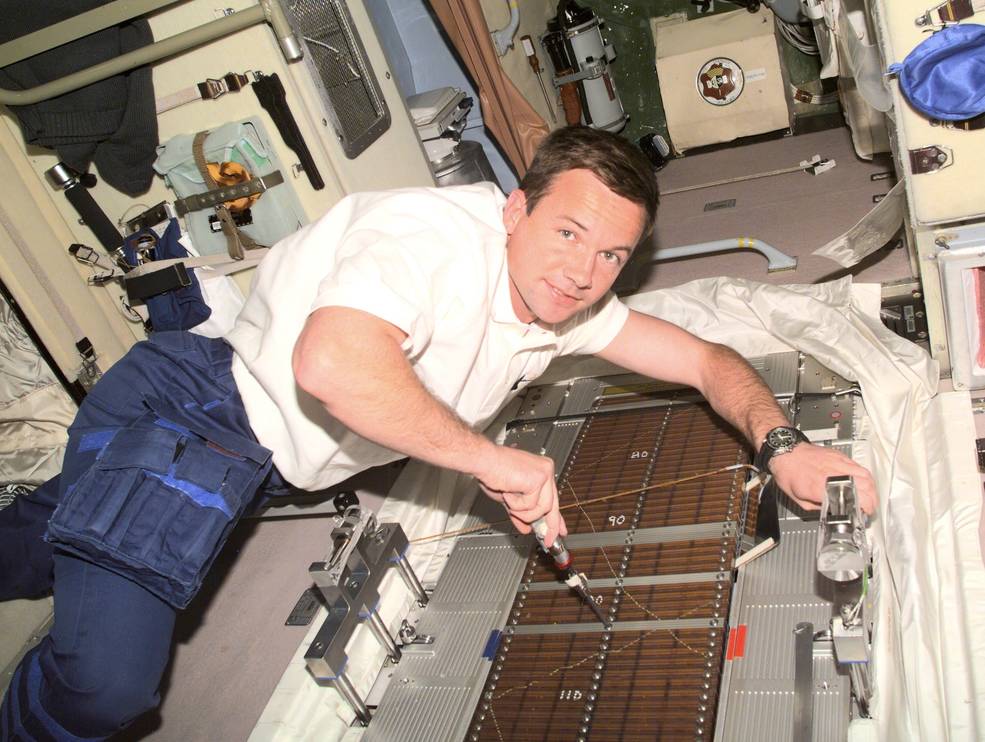
Left: European Space Agency astronaut Umberto Guidoni opens the hatches to the Raffaello Multi-Purpose Logistics Module. Middle: During the second STS-100 spacewalk, Scott E. Parazynski prepares to install an avionics package on the space station. Right: Cosmonaut Yuri V. Lonchakov representing Roscosmos conducts maintenance on the space station’s treadmill.
During the next three days, transfers from the MPLM continued and crew members transferred several powered active experiments from the shuttle’s middeck to EXPRESS Rack 1. The active experiments included a plant growth chamber, two protein crystallization facilities, and a commercial bioprocessing facility. Other experiments transferred and installed in Destiny included a phantom torso, a life-size model of a human upper body embedded with radiation detectors, part of a suite of radiation experiments that included the Bonner Ball Neutron Detector delivered to the station during the STS-102 mission. The crew members also loaded the MPLM with equipment no longer needed on station for return to Earth. The shuttle crew members also conducted maintenance tasks on the space station, including repairing the treadmill.
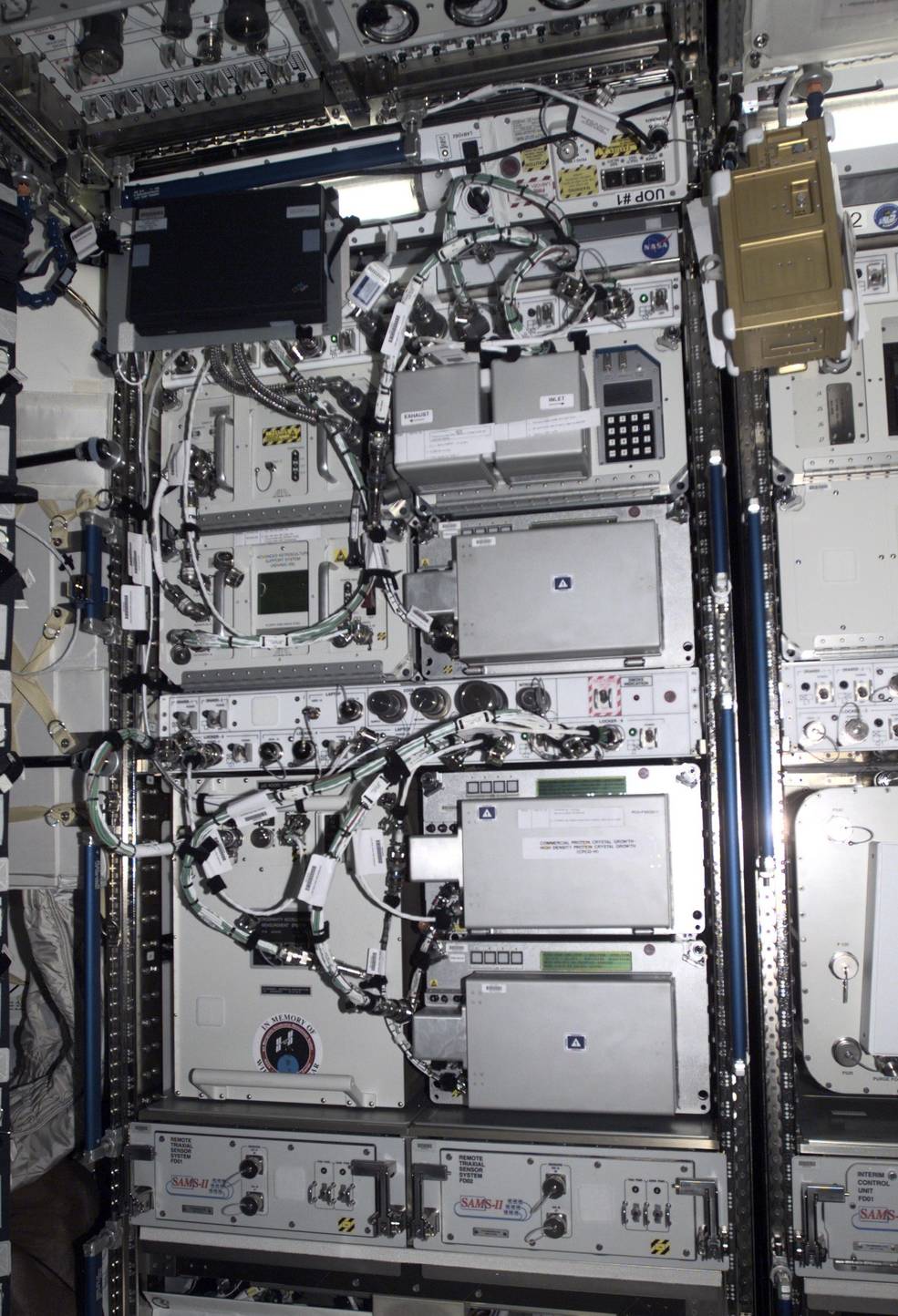
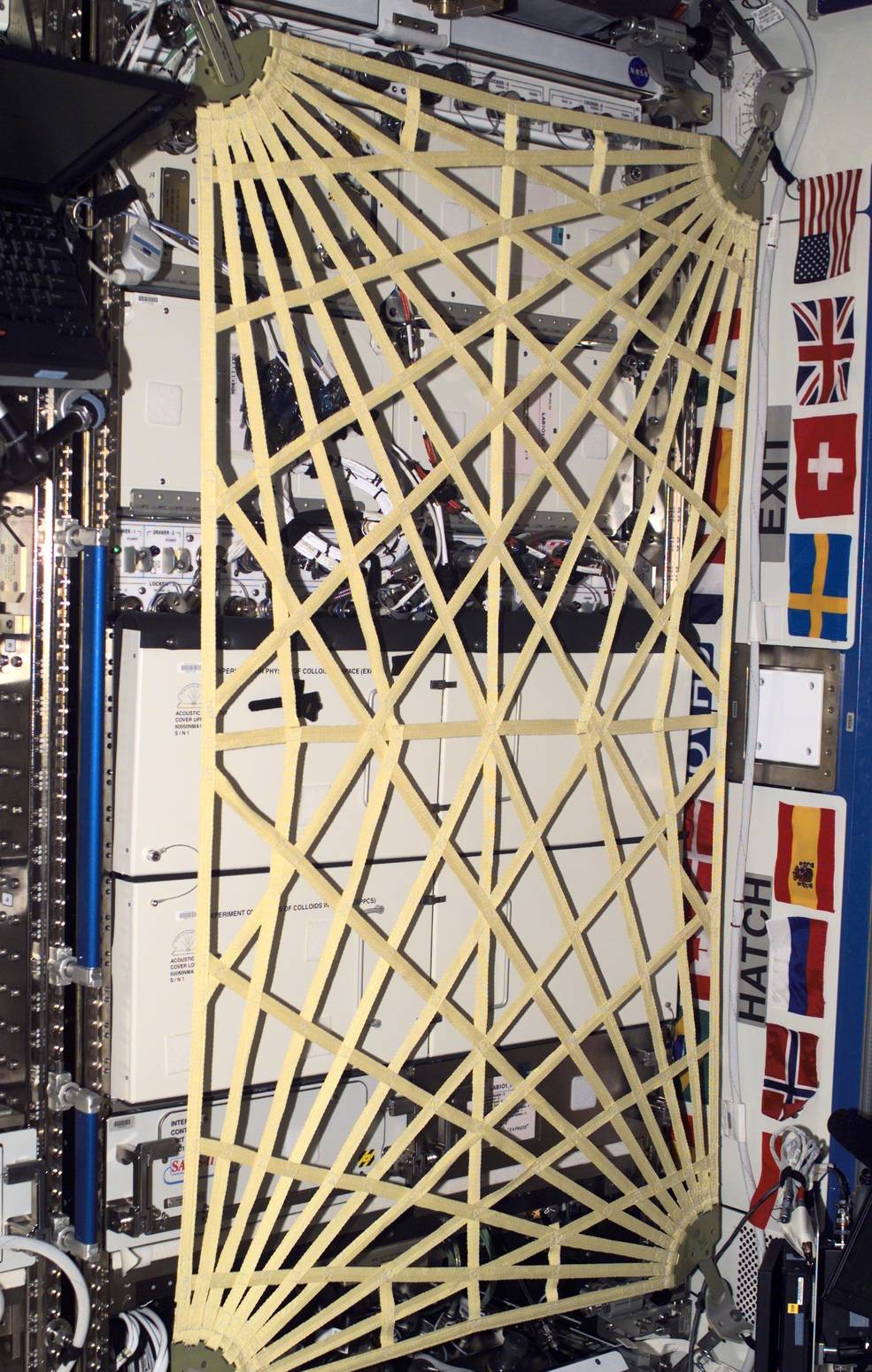
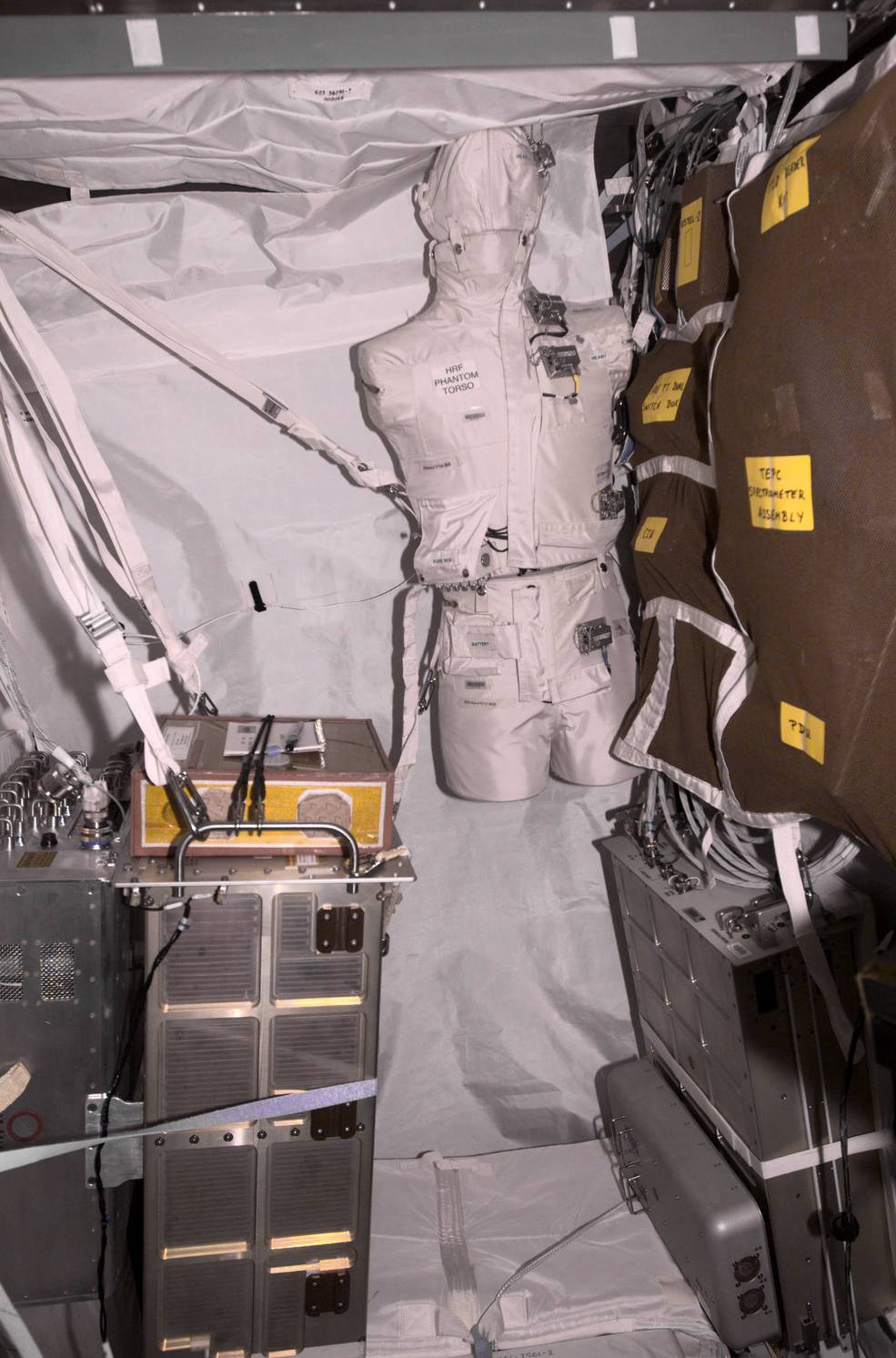
Left: The Expedite the Processing of Research for Space Station (EXPRESS) Rack 1, including the newly transferred powered experiments, installed in the Destiny module. Middle: EXPRESS Rack 2 installed in Destiny with its rack isolation barrier netting installed. Right: The Bonner Ball Neutron Detector, left, and the Phantom Torso radiation experiments in the Destiny module.
On the mission’s tenth day, using the shuttle’s robotic arm, Hadfield reached up and grappled the pallet and then Helms released it from the station’s arm, completing a historic “Canadian handshake” in space. Hadfield returned the now empty pallet to the shuttle’s payload bay. With all the transfers completed, the crews closed the hatches to the MPLM and Parazynski returned it to the payload bay using the shuttle’s robotic arm. Rominger fired Endeavour’s thrusters to raise the space station’s orbit. Then it was time for the two crews to say their goodbyes after eight days of joint operations, and they closed the hatches between the two spacecraft for the last time.
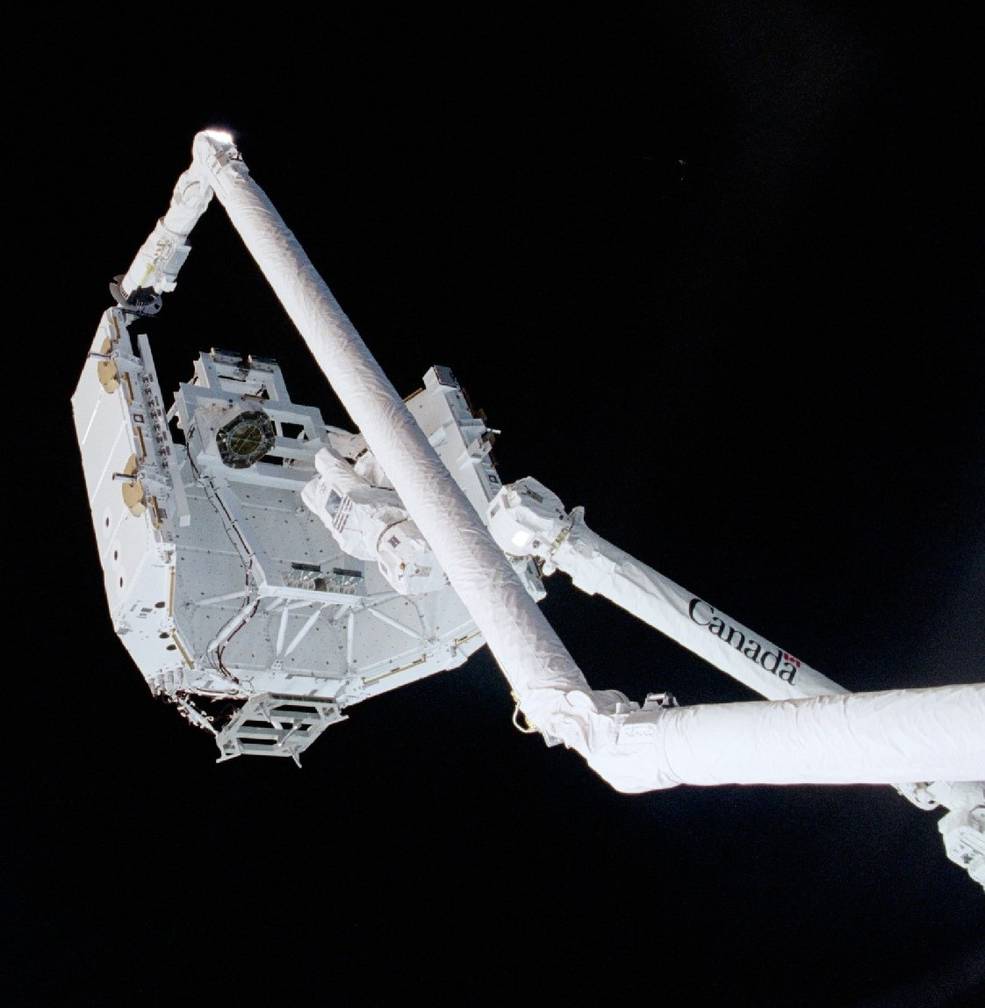
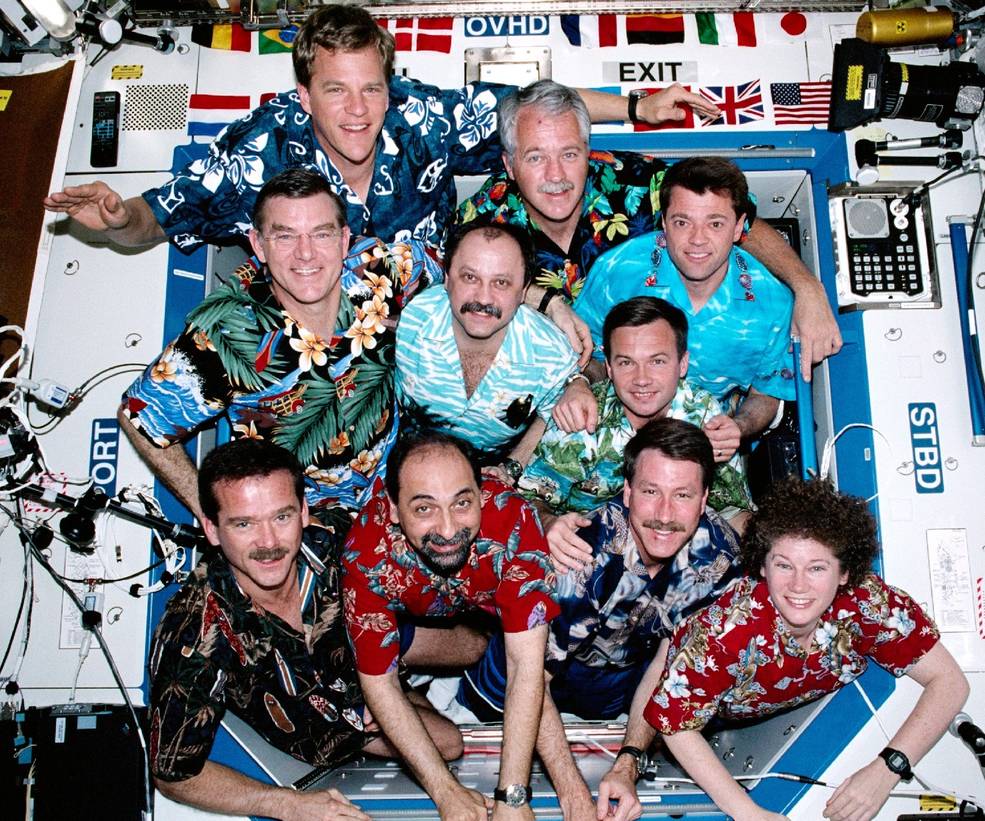
Left: The “Canadian handshake” as the shuttle’s robotic arm, left, takes the pallet from the station’s robotic arm. Right: The Expedition 2 and STS-100 crews, decked out in Aloha shirts for their farewell ceremony.
The following day, with Ashby at the controls, Endeavour undocked from the space station. He flew Endeavour around the station as the crew photographed it, with the newly installed Canadarm2 clearly visible. With inclement weather at the primary landing site at KSC on May 1, Rominger brought Endeavour home for a smooth landing at NASA’s Dryden Flight Research Center, now NASA’s Armstrong Flight Research Center at Edwards Air Force Base in California. The mission to install the Canadarm2 onto the space station lasted 11 days 21 hours 30 minutes.
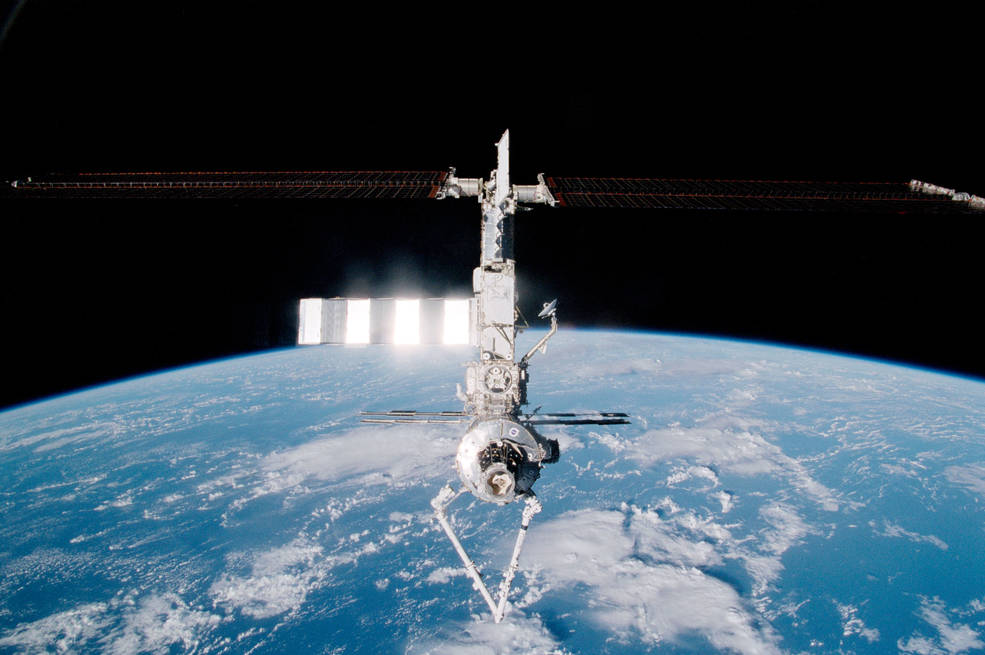
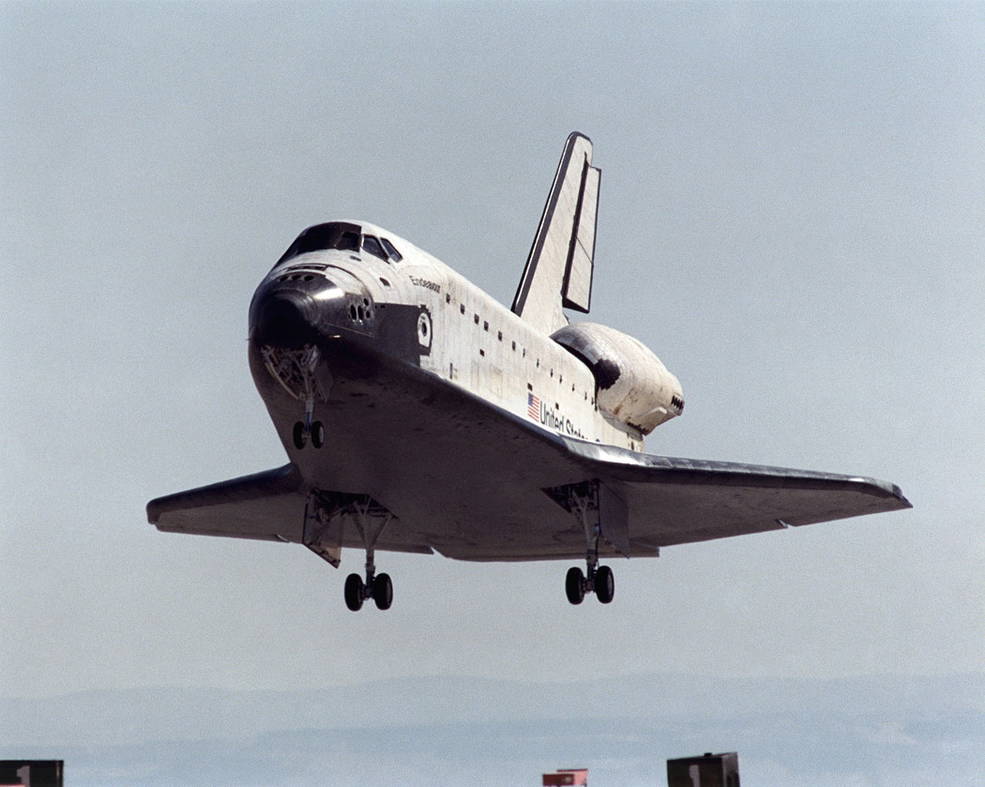
Left: The International Space Station photographed by the STS-100 crew during
departure, showing the newly installed Canadarm2 at bottom. Right: Space
shuttle Endeavour approaches the runway at NASA’s Dryden Flight Research
Center, now NASA’s Armstrong Flight Research Center, in California.
Enjoy the crew-narrated video about the STS-100 mission.
To be continued…









